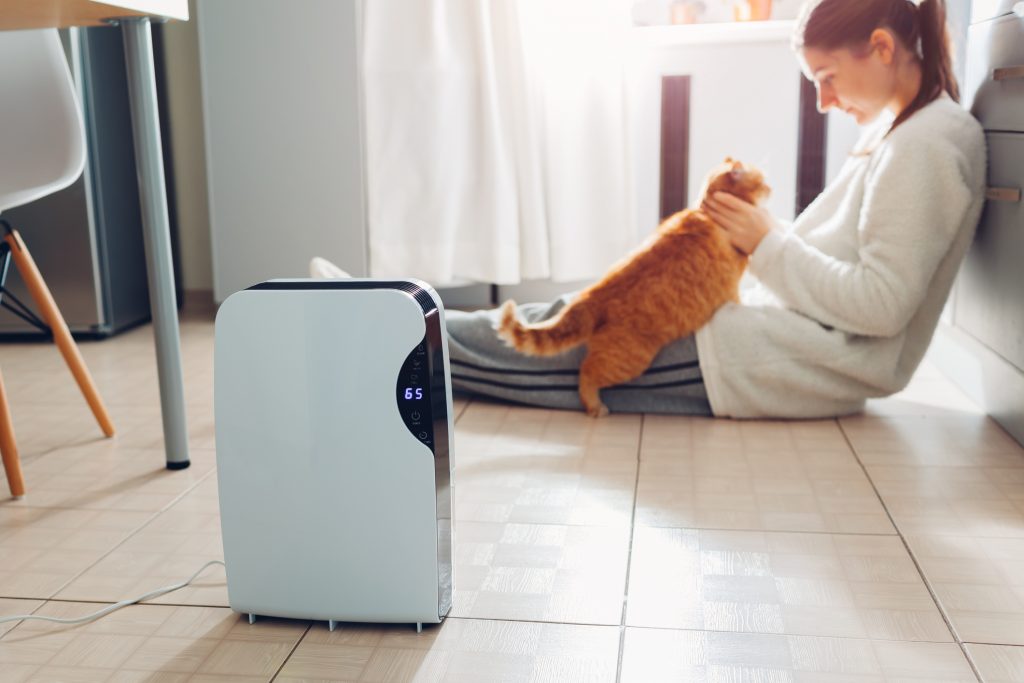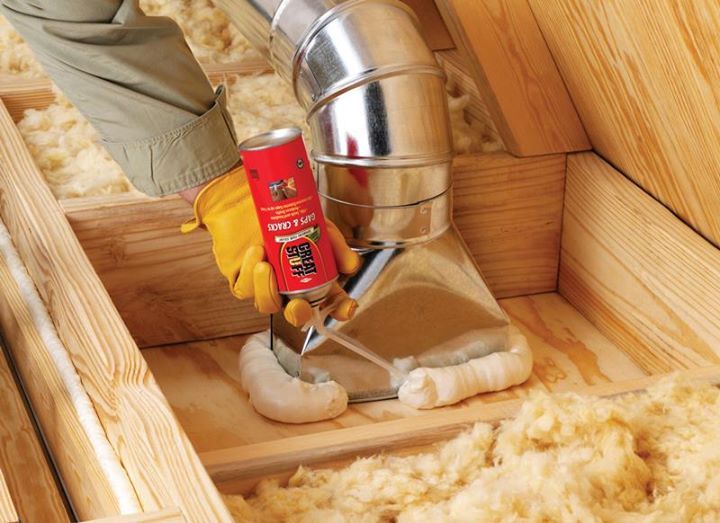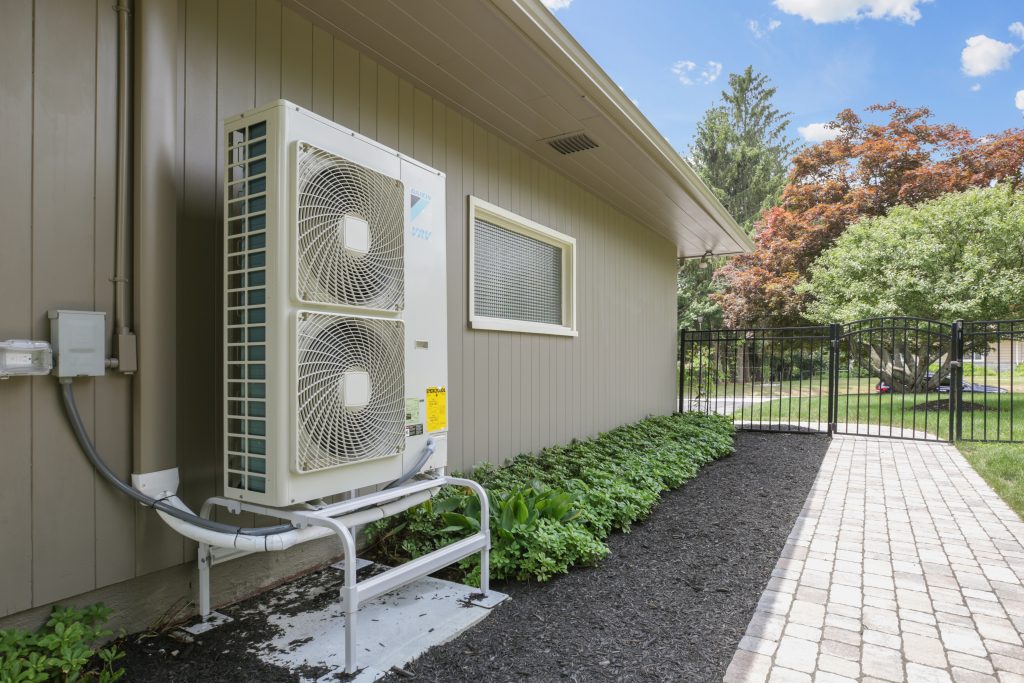Chilly basement? We’ll walk you through how to warm it up for good.
If your home is like most in North America, the basement is one of the coldest rooms in the house—it’s a big reason many homeowners ignore their basement until spring comes.
But there’s no need to avoid your basement just because it’s cold!
With some effort and strategic home upgrades, you can make your basement warm, comfortable, and worth spending time in.
Really.
In this complete guide to keeping your basement warm, you’ll cover:
- Answer: Why is my basement so cold?
- How to make your basement warmer quickly
- Long-term solutions to a too cold basement
- How to warm up a basement with basement insulation and air sealing
- The basement heater that’s most efficient (and keeps your whole home comfortable)
- How to get a home comfort makeover at no upfront cost
Ready to feel more comfortable in every part of your home? Let’s get started.
Spoiler alert: The final fixes for a cold basement and uneven temperatures are insulation and air sealing upgrades.
And you could get these permanent fixes at no upfront cost if your house qualifies.
Why is my basement so cold?
The question of the hour—and there are a few reasons behind why your basement can feel like a cooler.
- It’s lower than the rest of your home
- It’s not insulated correctly
- The foundation is full of holes
- The Stack Effect is in full effect
- Your heating system is old and outdated
- The thermostat is in the wrong place
- Your basement is too humid
It’s lower than the rest of your home
In the you-knew-that-already category, we have location. Yes, basements are built underground, which can help to keep the temperature steady all year.
But because heat rises, that steady temperature is often colder than most folks would prefer in winter—especially if your HVAC system isn’t up to the challenge of heating a multi-story house.
It’s not insulated correctly
Lack of appropriate insulation is another common reason for cold basements. Basements are often an afterthought when it comes to insulation, which means they’re not as well insulated as the rest of the house.
This can be a big problem in winter, when the outside air is much colder than the air inside your house—and there’s nothing to stop that outside air from forcing its way into your basement.
90% of U.S. homes are under-insulated.
NAIMA.org
The foundation is full of holes
This is a big one!
Most houses in the U.S. are full of tiny holes that let air in from the outside. Lots of those holes are in the foundation, which is basically an open invitation for winter air to invade through the bottom of your house’s structure.
By the way, these two factors together—under-insulation and air gaps— are the basis for the next big reason your house has a freezing basement.
The stack effect is in full effect
The stack effect is caused by the difference in density between warm air and cold air.
Warm air is less dense than cold air, so it rises. And if your house has any gaps (see above!) or it isn’t well-insulated (see above again!) cooler, denser air from the outside will rush in to fill the vacuum.
This vacuum creates a convection current that can keep your basement much colder than the rest of your house. And this same air current can actually make the rest of your house feel pretty drafty. Read How to fix a drafty house to learn more.
To see just how outside air can create a chilly, drafty, energy-wasting home, check out this video below for a quick visual.
Your heating system is old and outdated
The stack effect might be mitigated somewhat if you have a super-efficient heating system that offers precise zone-by-zone temperature control—like a cold-climate heat pump.
But if you don’t have a heating system that offers temperature zoning, there’s a good chance your HVAC is trying to heat the entire house to the same temperature (with unfortunate results).
And if your house is underinsulated—about 90% of U.S. homes are—and has air leaks (most homes do!) your heater has been overworked and is worn out (1).
Basically, if your heating system is older than about 10 years, it’s almost inevitable that the basement doesn’t get as much heat as the rest of the house.
And if your heating system is outdated, there’s also a good chance that…
The thermostat is in the wrong place
Thermostats are often placed in a spot that doesn’t accurately measure the temperature in the basement—which means your heating system may not even know it’s cold down there!
We put this toward the end of the list, though, because it’s a little tricky to solve. A common mistake here is to assume that moving the thermostat—or adding extra sensors—will solve the problem.
Unfortunately, that usually doesn’t work, because the thermostat issue is almost always just the tip of the iceberg.
Basically, yes, you need to fix this issue, but moving the thermostat is all you do, you’re going to be disappointed with the results. (Hang in there! We’ll give you the right fixes below.)
To learn why every home should upgrade to a smart thermostat, read our Ultimate Guide to Smart Thermostat Systems.
Your basement is too humid
Finally, basements are often pretty damp, which makes it harder for your body to regulate its own temperature.
That phenomenon can really change the “feel” of the heat, which means that even if the air in the basement is at a good temperature, it might still not feel very comfortable to you. An irritating complication, for sure.
Those—in brief—are the main freezing-basement culprits. So how do you fix them?
How do I keep my basement from getting too cold? Short-term fixes
Okay, since you’ve made it 600 words into an article on cold basements, we’re going to assume you have an immediate (and annoying) problem.
So let’s start with some immediate fixes.
- Buy a space heater for the basement
- Temporarily “seal” your doors and windows with door sweeps
- Use rugs and textiles to keep floors bearable
- Run a portable dehumidifier in your basement
Let’s dig into the ways to temporarily make your basement more comfortable (while you’re working on getting together some long-term fixes that we’ll explain below). Tap here to jump ahead to long-term fixes.
Buy a space heater for the basement
This is probably the most popular short-term solution for a cold basement. And it makes sense.
Space heaters are relatively cheap and easy to use, and they can make a big difference in the comfort of your basement—quickly.
So go for it! In the short term, at least.
The major issue with buying a space heater is the temptation to let it be a long-term solution. Don’t do that.
Space heaters are one of the least efficient ways to heat your home, and there are safety issues you won’t want to deal with for long (2).
Leaving on a space heater for just 8 hours a day can add at least $42.30 to your energy bill every month (3)!
(And if you do decide to go this route, remember to never leave a running space heater unattended, and make sure it’s placed on a level surface away from any flammable materials.)
Temporarily “seal” your doors and windows with door sweeps, weather stripping, and heavy curtains
One way to stop cold air from sinking to the basement? Prevent it from entering your home in the first place.
Use door sweeps and weather stripping to temporarily seal your doors and windows, as well as heavy, thermal curtains to help block drafts.
Note that these solutions are far from perfect (nothing will replace professionally-done, whole house air sealing), but they’re better than nothing and can certainly help in a pinch.
Check out this step-by-step tutorial below to learn how to weatherstrip a door. (But remember, this is just a quick solution! Your home needs top-to-bottom sealing to really stop drafts in your basement for good.)
Use rugs and textiles to keep floors bearable
If your basement floors are freezing, throwing down some rugs or other textiles can make them feel a lot better.
The benefits don’t stop with your feet—extra rugs will provide a bit of “floor insulation,” too, by slowing down any heat exchange that might be happening through an uninsulated basement floor.
Read Why are my floors so cold? to learn how to stop freezing feet for good.

Run a portable dehumidifier
A really humid basement makes the “effective temperature” feel cooler than it actually is, which is why dehumidifying the air in the basement can make it feel a lot more comfortable. Don’t overdo it, though—35–50% humidity is ideal (4).
Word to the wise: Be sure to empty your dehumidifier’s tank regularly or hook it up to a drainage system.
Otherwise, you’ll end up with a whole different set of problems. (This is a big reason why we recommend whole-house HVAC that automatically balances your home’s humidity.)
These fixes will certainly help the problem, but they won’t solve anything long-term.
To get the best in comfort and efficiency, you’ll need to fix the source of the issues—starting with sufficient insulation.
Long-term fix 1: Keep cold air out of your basement with basement insulation and air sealing
Here’s the plain truth: If your basement is cold in the winter, it’s a red flag that way too much cold air is getting into your house.
In other words, your house’s thermal barrier (that is, the way your house keeps outside air out) isn’t working correctly.
The solution? Fix your house’s thermal barrier.
And that’s a two-step process:
Make sure your basement (and attic!) are thoroughly insulated
The first step here is, obviously, to make sure your basement is properly insulated.
That means insulating the basement walls and rim joist to keep moisture and cold air out, as well as insulating your basement’s ceiling and any crawl spaces to keep heated air where it’s supposed to be (you know, indoors). Read How to get rid of moisture in a house to learn more.
Bonus: These upgrades also help with keep your floors warm!
To solve the problem of a cold basement, you have to address your attic, too.

The insulation upgrade shouldn’t stop at the basement, though.
Strangely enough, if you want to keep your basement warm, it’s equally important to insulate the top of your house—specifically, any attics in your house.
If that piece of advice sounds a bit suspect, think again about the stack effect: Hot air rises to the top of your home and escapes through the roof, which creates a current that pulls in cold air through the bottom of your home.
Now, let’s think about what would stop the stack effect.
Let’s say that hot air rises to the top of the house—and is held there by an effective thermal barrier (i.e., sufficient attic insulation).
In that case, the convection current (the one that pulls cold air into your home through your basement) will significantly reduce circulating air—because there’s simply no place for the cold air to go.
The whole ugly cycle grinds to a halt! Every room can be more comfortable… no more drafts!
But if your attic is under-insulted (or not insulated at all, which is common with large, old houses), then all your expensive, warm air will escape through the roof—and pull cold, uncomfortable air in through the basement and foundation. No good.
(And we’re guessing this is what you’re dealing with now—since 90% of homes are underinsulated.)
You heard it here first! For a truly insulated basement, you also need an insulated attic.
Air seal your home
The other necessary step to fixing your home’s thermal barrier? Air sealing.
The quick overview, here, is that most houses are full of tiny holes and air gaps—especially around the windows, doors, and foundation.
These tiny holes aren’t easily visible, but they cause a lot of energy waste in homes. They also play a huge role in why your house (and basement) gets so cold and drafty in the winter.
You lose 25–40% of the energy you pay to heat and cool your house through air leaks.
EnergyStar.gov
Basically, leaving all those holes and gaps open is kind of like leaving a window open in your house all winter long—the effects are that significant.
The way to fix the issue?
Crawl around your entire house with spray foam sealant, specialty tapes, gaskets, and caulk. Painstakingly find and seal every one of the hundreds of tiny gaps. Avoid all spiders.
In other words, air seal your home. It’s one of the best improvements for home energy efficiency.
(Our official recommendation is to hire a professional to do it. Why? If you do air sealing incorrectly, the best case scenario is you miss air leaks and still have energy waste… and the worst case scenario is that you cause moisture issues in your house).
Learn more about air sealing here. Or find out how you can get air sealing in your area for no upfront cost.
Long-term fix 2: Get a great basement heater (that’s also amazing in the rest of your house)
Of course, even if you do fix your home’s thermal barrier, you’re still not quite out of the woods.
You still need a heating system that can heat your entire house—not just the upstairs.
The best way to heat your house and your basement? A ductless mini-split heat pump.

There are many reasons why, and you can learn more about all your home heating options here, but here are a few heat pump highlights:
- Ductless mini-split heat pumps are by far the most efficient (and effective) way to heat and cool your entire house. A heat pump is up to 3x more energy-efficient than a standard HVAC heating system (5)
- Despite the name, heat pumps can heat and cool your home—a heat pump system is an all-in-one replacement for your current HVAC.
- Heat pumps don’t require any ductwork. That’s great news if your basement doesn’t have any ducts, or if the ductwork in your house is in bad shape.
- Ductless heat pumps offer zone-by-zone comfort. You can even keep the basement at a different temperature than the rest of your house.
- Heat pump heat is super comfortable. Think fresh, constantly-flowing heat—with absolutely no smell.
- Ductless heat pump systems come with an air filter and dehumidifier built right in—hello, better air quality! Better humidity control also means that your warm air will actually feel warm.
There’s so much more to say about heat pumps (you can get the full story on whole house heat pumps here), but the short version is this…
Heat pumps are, by far, the most reliable, most energy-efficient way to heat your home and your basement. They’re pretty much the Tesla of HVAC.
Which brings us to the important question: How do you get one?
And, maybe more to the point: how can you coordinate the finances and logistics of upgrading your HVAC at the same time as fixing your home’s thermal barrier?
Read on!
Get a complete basement solution for NO upfront cost. (It’ll also make the rest of your house feel great!)
The good news here is that the upgrades that make your basement warmer will also make the rest of your house feel incredible—and drastically cut your home’s energy waste.
The bad news: Home upgrading can be a huge project—involving tons of money, time, resources, stress.
But, hey, there’s actually more good news (we promise we’re done after this).
With Sealed, your home upgrades could be the least stressful project you do this year (or this decade).
In fact, we’ll work alongside you to create a custom home upgrade plan for a home comfort makeover that will make your house feel better 24/7/365.
Then we’ll hire the contractors, take care of all the details, and basically oversee the entire project from start to finish.
No stress or worry on your end.
Best of all, you don’t have to come up with any money upfront. If your house is eligible, you can pay for the work done with a flexible payment option that works best for you and your budget. (Learn more about the payment plan.)
And we stand by our work.
Basically, your monthly costs won’t change much… but your monthly comfort? That’ll change a lot, and for the better.
Interested? Tap here to see if your house qualifies.